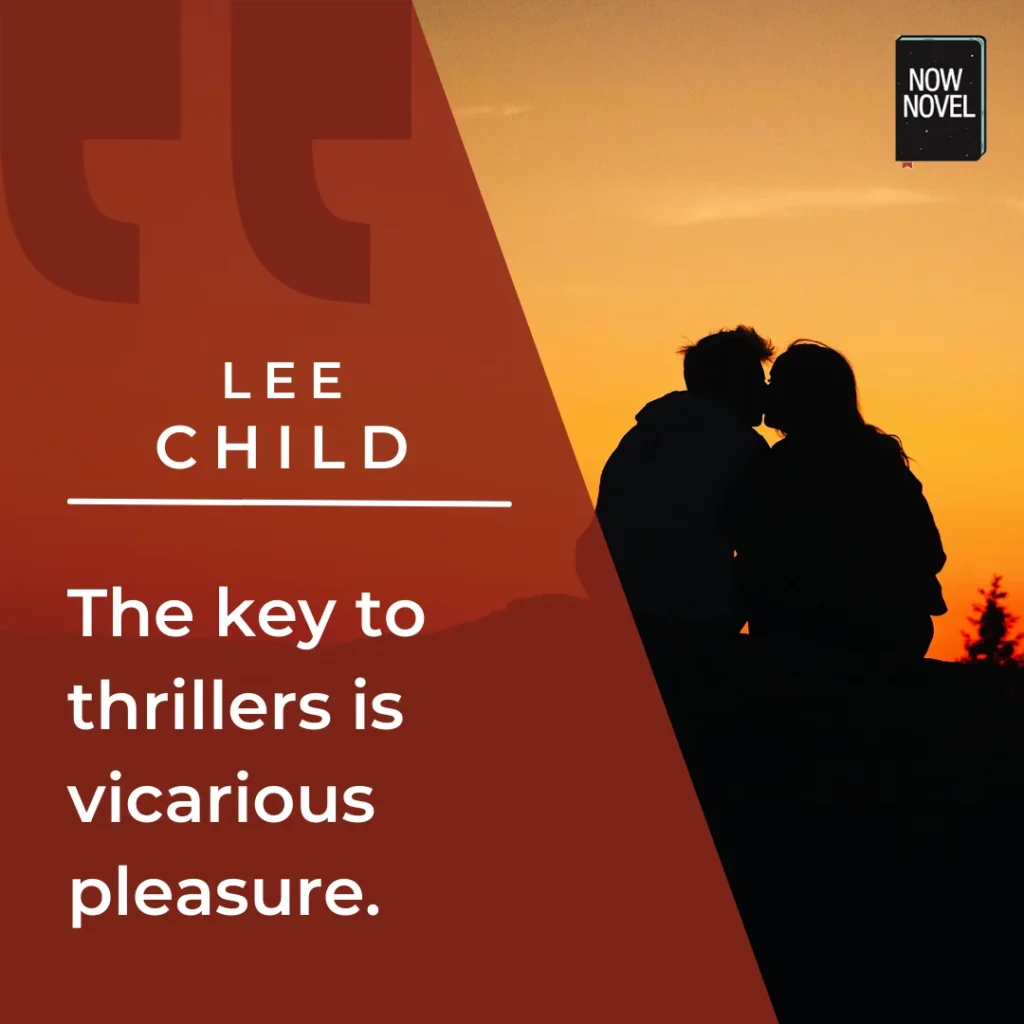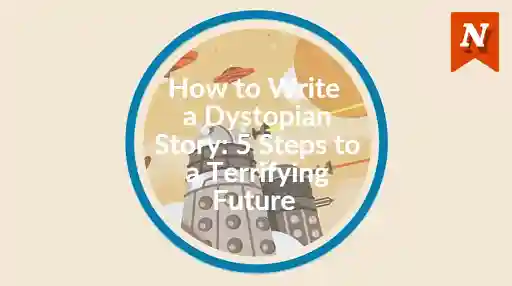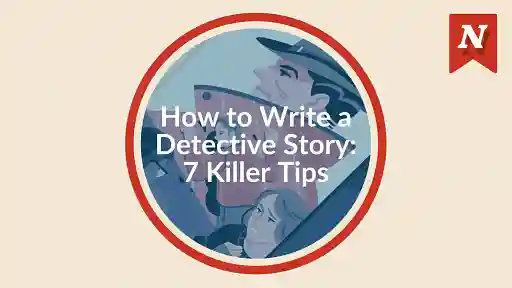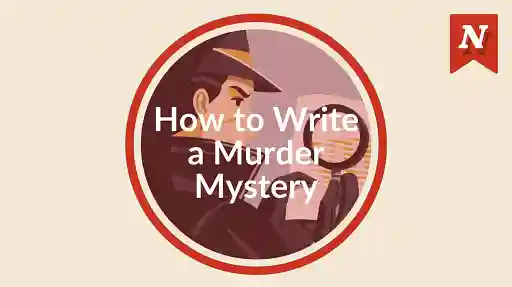Learning how to write a thriller, and popular thriller types, will help you write an electric read. Read tips from the best thriller authors plus tricks to ratchet up suspense and keep fast pace:
How to write a thriller novel
Here's a summary of how to write a thriller story that has fast pace and a plot that keeps your reader guessing (keep reading for more detail and examples):
-
Explore thriller types and find your idea
First, explore thriller subgenres - are you going to write a crime thriller, paranormal, legal, or other type of book?
-
Develop thriller plot ideas using GMC
Next, brainstorm characters and their goals, motivations, and the conflicts these lead towards.
-
Make pacing quick, actions urgent
As you write, focus on action, dialogue and tight description over long-winded narration.
-
Make plot put your reader on shifting sand
As you draft, think about things like reversals, plot twists and surprises that make your reader reassess what they thought they knew.
-
Understand the psychology of suspense
To write a gripping thriller, you need to make your reader both fear and hope for an outcome. Fear grows as stakes rise.
-
Tease and caution to heighten suspense
Use tone, mood and atmosphere to heighten suspense and think about troubling signs and signals that could make readers hold their breath.
-
Create arresting tone and mood
Great thriller auteurs linger on shots like street lights at night turning red to create foreboding.
-
Study the best thriller writers
Study authors such as Agatha Christie (for crime) and Stephen King (for paranormal) who are skilled in many of the writing techniques thrillers require.
Keep reading for more on each of the above steps to a good thriller:
Explore thriller types and find your idea
What is a thriller? The genre is commonly grouped with mystery and suspense (as Amazon does in their book listings). These genres share several elements. Thriller novels typically:
- Explore darker subjects such as violent crime
- Focus on tense or urgent action and turbulent relationships
- Have quick pacing
- Keep readers guessing with twists and deferred (yet crucial) resolution
- Involve high-stakes scenarios (e.g. terrorists taking over a high rise in the Die Hard trilogy)
Types of thriller novel
First, what type of thriller novel do you want to write? It is an eclectic genre that includes:
- Crime thriller in which a murder or other serious crime features prominently
- Spy/espionage thrillers that feature elements such as secret agents, surveillance and geopolitical tension
- Psychological thrillers which typically feature psychologically distressed viewpoint narrators (e.g. Scorsese's classic film Taxi Driver about a Vietnam veteran)
- Legal thrillers in which court cases and the legal system feature
- Political thrillers that explore assassination plots and the like
- Supernatural thrillers where paranormal elements are usually more incidental than in horror. For example, a story about a cop who can communicate with ghosts
These are just a few of the thriller subgenres available.
To start your story and finesse your thriller idea, complete the 'Central Idea' prompts in the Now Novel dashboard.

Develop thriller plot ideas using GMC
How to develop thriller plot ideas: Stakes and story tension arise from characters' goals or desires, motivations. Conflicts that arise from opposing (or taboo) desires drive the narrative.
'Goal, motivation and conflict' (formalized by Debra Dixon in her book GMC: Goal, Motivation, and Conflict) are agents of change.
It's change plus tension and suspense - chains of urgent change showing cause and effect - that makes thrillers gripping reading.
How goal, motivation and conflict works in thrillers
Deeds and goals in thriller stories
In thrillers, an antagonist or wrongdoer's deeds and goals are often criminal or outside the bounds of moral conventions.
This wrongdoing and its possibly mortal dangers or extreme stakes and consequences is part of the thrill.
Many thrillers (especially psychological thrillers) spin dark tales from the fact that we never, truly know a person completely:
I saw a quote the other day that was something along the lines of you only know what someone is willing to share with you, so you might never really know a person. We like to think that we know everything about a family member or a partner or a best friend, but do we? Probably not. Exploring intimate relationships with the backdrop of a thriller is so fascinating to me.
Jeneva Rose, Q&A for Fresh Fiction blog, April 25th 2022
What drives action and motivation in a thriller?
In thrillers, characters' deeds and goals necessitate action. Whether the protagonist must rescue hostages or defend a lover who is suspected of murder, it's urgent.
Our motivation is naturally higher when there are more terrible, potentially devastating stakes or feared outcomes.
What do the high-rise hijackers want in Die Hard? What does attorney Sarah Morgan want when her husband's mistress is found stabbed to death in Jeneva Rose's The Perfect Marriage?
Thrillers thrive in internal and external conflict
Sarah Morgan is a good example of an intriguing thriller protagonist. Emotionally conflicting experiences drive her actions. The external conflict of uncovering spousal infidelity, firstly. Then the internal conflict of her defending her husband against a murder charge.
People often write of 'plot' and 'character' as though they are totally separate categories. Yet in truth, 'plot' emerges out of characters whose desires and motivations are sometimes known, sometimes not. Often opposed or in a state of flux.
Duplicity and deception are staples of the thriller genre because it so often deals with characters who have secrets. The genre often features people who venture into morally darker, more conflict-riddled territory.
Conflict in a thriller - as with other genres - grows from the 'why not' that stands in your MC's way, as Now Novel writing coach Romy Sommer shares:
Make pacing quick, actions urgent
An essential ingredient in how to write a thriller is fast pacing.
Thriller reviewers often mention reading a book 'in one sitting' or say 'I couldn't put this book down'.
For example, two 'shouts' for the novel we discuss below from Amazon review extracts:
"I couldn't put this book down!"
The Perfect Marriage, reviews via Amazon.
"I can count on one hand the number of books I've read in a single sitting. This is one of those books!"
How to create fast pacing for thrillers
Let's explore the opening page to Jeneva Rose's The Perfect Marriage, a thriller that has over 24,000 Amazon reviews.
This particular thriller keeps pace fast by:
- Keeping the prologue short (and focused on a core, dramatic question - 'Did he kill her?').
- Throwing the reader straight into action and character emotion.
- Using dialogue to establish tone and mood fast.
- Using a cliffhanger - we don't know the answer to the question yet.
When the outcome of a scene or chapter is left hanging, the pace naturally picks up because the reader will turn the page to find out what happens next.
Jessica Page Morrel, '7 Tools For Pacing A Novel & Keeping Your Story Moving At The Right Pace', Writer's Digest, 2012.
Dissecting a thriller prologue
The prologue to The Perfect Marriage is only 8 lines long. It begins with the active question 'Did he love her?' and ends with the question 'did he kill her?'
Did he love her? He loved the way she looked at him - the way her bottom lip trembled and her foot quaked when she… [but] did he kill her?'
Jeneva Rose, The Perfect Marriage, 2020
Between these leading questions, there is detailed sexual description implying a carnal relationship. This implied physical intimacy jars with the final line's implied violence.
This juxtaposition and sense of rollercoaster distills characteristics of thrillers generally. Their darker subject matter, and the way they often explore turbulent scenarios, desires and actions that veer between extremes.
The imagery and language may be a little obvious, but this is not a more 'literary' thriller. Commercial thrillers maintain accessible (even if at times obvious or rote-seeming) style.
How to begin a thriller with fast pace and action
How do you begin a thriller story with quick pacing?
Let's look further at the opening pages of The Perfect Marriage.
After the prologue, the first chapter (subtitled 'Sarah Morgan' to indicate the viewpoint narrator) continues. The first chapter:
Launches into an emotional scene in medias res (in the middle of the action). Chapter 1 begins with the spoken words, "Not again." This creates an immediate sense of a situation already unfolding.
Creates the narrator's POV and emotional state fast. The opening quickly proceeds in Sarah Morgan's POV, without narrated exposition or backstory:
The disappointment in his voice fills the room and hangs there like a light flog, clouding us from one another. I take in a deep breath, removing the haze, and let it out just as quickly, clearing the path back between us. I don't need to look at him to know his eyes are disheartened and his lips pressed firmly together. I don't blame him. I've disappointed Adam again.
Rose, The Perfect Marriage
Gives clear, simple and descriptive actions. After the above line, we read, 'I slide a white blazer over an emerald-green blouse and straighten out my pencil skirt.'
Key takeaways for pacing a thriller from the above:
- Skip lengthy narrated, told backstory and place the reader immediately in an unfolding scene or moody snapshot
- Use concise, emotion-driven dialogue - just two words in the opening line ('not again') convey disappointment/frustration
- Bundle concrete, succinct actions with description - note how the description of the pencil skirt is dual-purpose, telling us what Sarah is wearing while also suggesting discomfort
- Create clear or implied conflict: Sarah and Adam's exchange and her gestures create a clear sense of tension between them

Make plot put your reader on shifting sand
Thinking about how to write a psychological thriller? Put your reader on shifting sand. So that just when they think they have everything figured out, new information has them guessing again.
Film actor Mark Strong, interviewed by Collider, said:
When you’re making a psychological thriller, what you need to do is have an audience on shifting sand so they’re never quite sure where they are. But if I flag that too heavily with the character, I think that’s the wrong way to go. I have to play him, as I said, just dead straight.
Mark Strong, interviewed by Sheila Roberts, Collider, 2014.
How to keep thriller readers guessing
To keep that sand shifting and readers guessing, you could:
- Play with unreliable narrators. When a narrator is revealed to have lied, the reader must question the truth of any statement the narrator makes.
- Explore twists and reversals. Apart from characters actively lying, our perception of the 'facts' of a story may change with new information. For example, a bloodied chainsaw is revealed to have been used in a grisly tree-felling accident.
- Infer and imply. Mystery and suspense arise from inference and implication without (or rather, while delaying) confirmation.
- Multiply viewpoints. Jeneva Rose alternates viewpoints between lawyer Sarah Morgan and her murder suspect husband Adam. The switch between conflicting viewpoints itself may generate compelling narrative suspense.
Understand the psychology of suspense
Great thriller stories give us gripping suspense.
The standard definition of suspense is 'a state or feeling of excited or anxious uncertainty about what may happen' (Oxford Languages).
Psychologists of suspense have theorized that we feel suspense because of 'prospect emotions' such as fear and hope. We desire (or fear) a specific outcome (the wolf hunts the three little pigs, we identify with the vulnerable protagonists, and we (probably) hope straw, sticks and bricks will hold out).
How to create thriller suspense
You ramp up suspense by:
- Implying the possibility of a terrible outcome. For example, the protagonist discovers her husband not only was cheating on her but could also be a cold-blooded killer.
- Making a 'feared' outcome seem more likely than the 'hoped for' one. For example, the wolf successfully blows each of the first two pig's houses down in the fable - eek.
- Restricting, limiting, impeding. Obstacles always appear at the worst possible time in action thrillers (e.g. heroes are cornered in a dead end and have to parkour up a vertical wall).
The SEP describes the connection between suspense and the undesirability of an outcome using an odd orange analogy:
Fear is amplified as the degree of danger, the undesirability and/or likelihood of an outcome, increases. If I am fearful of being attacked, I am more fearful if the prospective attack is more undesirable: Given equal likelihood, I would be more fearful of being stabbed in the gut with a knife or a beaten about the torso with a pillowcase full of oranges than merely punched repeatedly.
'Aaron Smuts, 'The Paradox of Suspense', Stanford Encyclopedia of Philosophy, revised 26 October 2021.
Tease and caution to heighten suspense
Suspense in thriller stories doesn't only build because there is a feared outcome with mortal or other grave risks. Moment to moment, suspense may build due to:
- Signs with dark implications or connotations (red lights meaning 'stop', for example)
- Tone, mood and atmosphere that is foreboding, anxious or eerie
How often have you watched a thriller or horror and said, 'What are you doing?! Don't go in there!'
In thrillers novels, protagonists often take the wrong turn, or there is narrative irony (where the reader knows more than the character does about a place or situation) which also creates suspense.
The filmmaker David Lynch uses cinematography to excellent suspense-creating effect in the cult classic series Twin Peaks. A frame may linger, for example, on a traffic light at night changing from green to red. Or the camera lingers on the menacing spin of a ceiling fan, while a panic-stricken mother hunts for her daughter.
Setting in thrillers is your ally for creating unnerving tone and mood.
Create arresting tone and mood
Mysteries, thrillers and suspense novels share close attention to tone and mood. If you compare the two prologues of contemporary thriller bestsellers, The Perfect Marriage and The Housemaid by Frieda McFadden (2022), there are overlapping features:
- Concision - each prologue is short and cuts to the chase
- Emphasis on a state of suspicion: Rose's novel begins by asking, 'Did he kill her?' while McFadden's first line is 'If I leave this house, it will be in handcuffs'
- Dark, foreboding tone and mood: The narrator of McFadden's prologue continues the line above with, 'I should have run for it while I had the chance. Now my shot is gone. Now that the police officers are in the house and they've discovered what's upstairs, there's no turning back.'
- Questioning tone: Each thriller prologue opens with a dramatic question
The two thriller novels discussed above are of course commercial, bestseller thrillers. This means that they are written in an extremely accessible (you might even say cliché-ridden) style.
Yet they achieve what great thrillers do. They make the reader keep turning pages because they have questions needing urgent answers.
Study the best thriller writers
Who are some of the best thriller writers? Readers love thriller authors such as:
- Dame Agatha Christie for her detective slash mystery/thriller novels (the late author's 78 books have sold over two billion copies)
- John Le Carré whose espionage/spy novels are often more introspective than action-packed, but create effective suspenseful tone and mood
- John Grisham whose legal/suspense thrillers are often describes as easy reads with engrossing, crafted plot lines
- Stephen King for thrillers with paranormal and horror elements
These are just a few of the big names in their respective thriller subgenres (or hybrid genres with thriller elements). The authors above published over 170 novels between them.
It is worth keeping up with contemporary thriller authors, too.
Keep track of nominated and awarded authors for major thriller prizes such as the International Thriller Writers Thriller Awards. Find thrillers to study in lists such as this list of the 100 greatest thrillers of all time for Stacker.
Start writing a thriller using Now Novel's story outlining tools. Get help developing your story from coaches and a constructive critique community.
Subscribe to our newsletter
One million authors use our writing resources to get their books published. Come join them.











Best way to write a thriller is to read one that isn't that well known for starters! If you’re into espionage try an unusually thrilling autobiography entitled Beyond Enkription (misspelt on purpose) by Bill Fairclough (ex MI6 agent codename JJ). It’s a must read for espionage cognoscenti. The fact based narrative is set in 1974 about a British accountant working in London, Nassau and Port au Prince who unwittingly works for MI6 and later the CIA. It’s a compelling read but whatever you do, don't just surf through the prologue as I did. Also, if like me you could only just stomach the film Jaws don’t be put off by the passing savagery of the first chapter. I finished this huge book in two sittings and a week or so later read it again. To get the most out of it try researching the real events behind it on the web. There is a lot out there once you start digging but as a minimum include a half hour read of one of the author's bios which don’t include spoilers. You’ll soon feel like you know his family. After my first reading I did even more research and kept on unravelling increasingly enthralling material that drove me to reread the book. My second reading was richly rewarded and just as captivating as my first. If you like raw or noir espionage thrillers, you’ll love it. Len Deighton and Mick Herron could be forgiven for thinking they co-wrote it. Atmospherically it's reminiscent of Ted Lewis' Get Carter of Michael Caine fame. If anyone ever makes a film based on Beyond Enkription they'll only have themselves to blame if it doesn't go down in history as a classic espionage thriller.
Janice Hope - Over 2 years ago
Hi Janice, thanks so much for your very detailed suggestions, I don't know the Bill Fairclough and that sounds fascinating, will definitely add to my 'TBR' list. Thanks for reading our blog and sharing your thoughts.
Jordan - Over 2 years ago
I've been working on a superhero series for over a year, now, and I'm realizing there are a lot of thriller elements in it (I killed off a throwaway character and nearly killed his protege before any of my superhero team even figured out what their powers were, had my villains try to kidnap one of the team before they even realized they might have superpowers, and my bad-guy organization has tried to deceptively and/or forcibly recruit the team mentor at least three times). Thing is, I'm not sure if I have a strong enough thriller tone to the story to be marketing the series as "thriller." Any thoughts on where to draw the line?
Wendy - Almost 2 years ago
Hi Wendy, thank you for sharing your question about your superhero series. That is an interesting question. Genre categories and Amazon marketing aren't my specialty (I'll be upfront about that) but I would say that with superhero being a subgenre of speculative fiction broadly, you could market your series as speculative fiction with thriller elements? This would give you more leeway to not have to have every trapping of a textbook 'thriller' while also targeting crossover audience, in my perspective. If you look at the 'superhero-thriller-fantasy' tagged books in Amazon's Kindle store, the top three listed are Robert J. Crane's Shadows, Blake Crouch's Upgrade: A Novel and Neil Gaiman's American Gods (the tenth anniversary edition), so I would look at these and the different categories they're listed under for ideas as well. I hope this is helpful! Thank you for reading our blog.
Jordan - Almost 2 years ago
Your blog on how to write a thriller is an invaluable guide for aspiring writers. Your step-by-step insights and practical tips provide a clear roadmap to crafting suspenseful narratives. A concise and effective resource for anyone looking to master the art of thriller writing!
Bruce - Over 1 year ago
Hello Bruce, it's great to hear your thoughts on the blog. It's so valuable to get feedback like this. All the best with your writing!
Arja Salafranca - Over 1 year ago